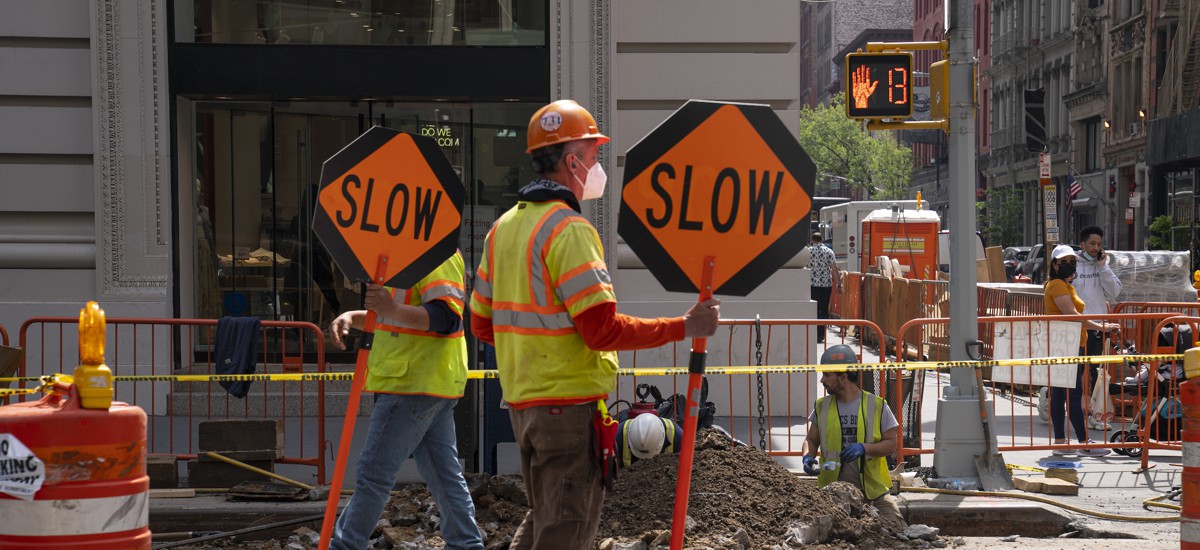Home>diy>Building & Construction>How Much Do Construction Flaggers Make


Building & Construction
How Much Do Construction Flaggers Make
Modified: February 25, 2024
Find out how much construction flaggers make in the building construction industry. Get insights on the average salary and earning potential for flaggers in this field.
(Many of the links in this article redirect to a specific reviewed product. Your purchase of these products through affiliate links helps to generate commission for Storables.com, at no extra cost. Learn more)
Introduction
Welcome to the world of construction flaggers, where safety meets efficiency on construction sites. These unsung heroes play a crucial role in ensuring the smooth flow of traffic while construction activities are underway.
Construction flaggers, also known as traffic control personnel, are responsible for directing vehicles and pedestrians around construction sites, keeping them safe and maintaining a consistent traffic flow. Their job is vital to prevent accidents and maintain the safety of both workers and the general public.
In addition to their main responsibilities, construction flaggers also serve as the eyes and ears of the construction crew. They communicate with equipment operators, crane operators, and other team members to coordinate activities and ensure everyone is working together harmoniously.
But how much do construction flaggers make for their important and demanding work? In this article, we will delve into the factors that affect their salary, explore the average salary range, and discover the additional benefits and perks that often come with the job.
Key Takeaways:
- Construction flaggers play a crucial role in maintaining safety and traffic control on construction sites, with average salaries ranging from $22,000 to $44,000 per year. Additional benefits and opportunities for advancement contribute to their overall compensation package.
- Factors such as location, experience, certifications, and employer type influence construction flaggers’ salaries. Understanding these factors and negotiating fair compensation is essential for flaggers to build rewarding careers in the industry.
Read more: What Does A Flagger Do In Construction
Job Overview
Construction flaggers play a critical role in maintaining safety and controlling traffic on construction sites. Their main objective is to ensure the smooth flow of vehicles and pedestrians, minimizing the risk of accidents and creating a safe working environment for construction crews.
Flaggers typically work alongside road construction crews, utility companies, and other infrastructure development projects. They are responsible for setting up work zones, including the placement of signs, cones, and barricades, to guide traffic and indicate changes in road conditions.
During their work shifts, flaggers use a variety of hand signals, flags, and radios to communicate with drivers and other crew members. They direct traffic, stop and start vehicles as needed, and provide guidance to pedestrians to ensure their safety. It is essential for flaggers to closely monitor the traffic flow, continuously assess potential risks, and make quick decisions to maintain order and prevent accidents.
Flaggers must also be knowledgeable about local traffic laws and regulations. This includes understanding the different traffic control devices and signs used on construction sites, as well as being aware of any special considerations or restrictions in the area.
Working as a construction flagger requires physical stamina and the ability to spend long hours outdoors, often in challenging weather conditions. The job can be mentally demanding as well, as flaggers must remain attentive and focused to effectively control and monitor traffic.
In addition to their traffic control duties, flaggers are also responsible for maintaining the safety of the construction crew. They communicate with equipment operators and other workers, ensuring that everyone is aware of potential hazards and coordinating activities to prevent accidents.
Overall, the job of a construction flagger is essential for maintaining safety and efficiency on construction sites. Their role as traffic control personnel is crucial for the success of construction projects and the well-being of workers and the public alike.
Factors Affecting Flaggers’ Salary
The salary of construction flaggers can vary based on several factors. Here are some key factors that affect their earning potential:
- Location: The geographical location can significantly impact a flagger’s salary. Urban areas with high construction demand and higher costs of living generally offer higher wages to attract and retain skilled flaggers. On the other hand, rural areas with lower construction activity may offer lower salaries.
- Experience: Like many professions, experience plays a crucial role in determining a flagger’s salary. Generally, flaggers with more years of experience and a proven track record of performance can earn higher salaries. Newer flaggers, especially those who are just starting their careers, may earn lower wages until they gain more experience.
- Certifications and Training: Flaggers who have additional certifications and specialized training beyond the basic requirements may receive higher compensation. These certifications, such as the American Traffic Safety Services Association (ATSSA) Flagger Certification, demonstrate a higher level of expertise and competence in traffic control and can lead to increased earning potential.
- Union Affiliation: Some flaggers may be members of labor unions, which can negotiate and secure higher wages on behalf of their members. Union-affiliated flaggers often benefit from collective bargaining agreements that establish standardized wages, benefits, and working conditions.
- Employer and Project Type: The specific employer and type of project can influence a flagger’s salary. Government agencies and large construction companies often offer better compensation compared to smaller contractors. Additionally, flaggers involved in complex and high-profile projects, such as highway construction or major infrastructure development, may receive higher wages.
- Working Hours: Flaggers may have the opportunity to earn extra income through overtime pay. Construction projects often require extended or irregular working hours, and flaggers who are willing to work additional shifts or weekends can increase their salary through overtime rates.
It’s important to note that each of these factors can interact and influence one another. For example, a highly experienced flagger working in a unionized urban area on a major infrastructure project may earn a higher salary compared to a new flagger in a rural area.
By considering these factors, construction flaggers can have a better understanding of the potential salary range they can expect and make informed decisions about their career path and desired working conditions.
Average Salary of Construction Flaggers
The average salary of construction flaggers can vary depending on various factors, as discussed earlier. According to data from the U.S. Bureau of Labor Statistics, the median annual wage for flaggers was $29,250 as of May 2020. However, it is important to note that this figure represents the midpoint of the salary range, and individual salaries can range above or below this amount.
Flaggers’ salaries can vary significantly based on location, experience, certifications, and other factors. In areas with high construction demand, flaggers may earn a higher salary to attract and retain skilled personnel. Conversely, in areas with lower construction activity or lower costs of living, flaggers’ salaries may be lower.
Experience plays a significant role in determining a flagger’s earning potential. Flaggers with more years of experience and a strong performance record may earn higher salaries compared to those who are new to the profession. Additionally, flaggers who hold specialized certifications or have completed additional training programs may have a competitive edge and be eligible for higher wages.
Union affiliation can also impact flaggers’ salaries. Labor unions often negotiate collective bargaining agreements that establish standardized wages and benefits for their members. Union-affiliated flaggers may have access to higher wages and additional benefits compared to non-unionized flaggers.
While the average salary provides a general indication of the earning potential, it is important to consider other factors such as the type of employer and project. Government agencies and large construction companies often offer better compensation compared to smaller contractors. Flaggers involved in high-profile projects or those working on complex infrastructure development may also receive higher wages.
It’s worth noting that construction flaggers may have the opportunity to increase their earnings through overtime pay. Construction projects often require extended working hours, and flaggers who are willing to work additional shifts or weekends can benefit from overtime rates.
Overall, the average salary of construction flaggers is influenced by several factors, including location, experience, certifications, union affiliation, employer type, and project complexity. By considering these factors, flaggers can have a better understanding of the potential salary range and negotiate fair compensation for their vital work in maintaining safety and traffic control on construction sites.
Salary Range of Construction Flaggers
The salary range of construction flaggers can vary based on several factors, including location, experience, certifications, and other considerations. While the average salary provides a general idea of what flaggers may earn, it is important to understand that individual salaries can fall both above and below this range.
In general, the salary range for construction flaggers can vary from around $22,000 to $44,000 per year. Entry-level flaggers or those with less experience may start at the lower end of the range, while experienced flaggers with additional certifications and specialized skills may earn salaries closer to the higher end.
Location significantly impacts the salary range of flaggers. Urban areas with high construction demand and a higher cost of living tend to offer higher wages to attract and retain experienced flaggers. On the other hand, rural areas with lower construction activity often provide lower salaries.
Experience also plays a critical role in determining where a flagger falls within the salary range. Entry-level flaggers with limited experience may start at the lower end of the range and gradually increase their earning potential as they gain more experience and develop a strong track record. Flaggers with several years of experience and a proven performance record may earn higher salaries that fall within the upper range.
Certifications and additional training can also impact a flagger’s salary range. Flaggers who have obtained specialized certifications, such as the ATSSA Flagger Certification, may be eligible for higher wages compared to those without such qualifications. These certifications demonstrate a higher level of expertise and competence in traffic control and can lead to increased earning potential.
Union affiliation can also influence the salary range of construction flaggers. Unionized flaggers may benefit from collective bargaining agreements that establish standardized wages, ensuring fair compensation and additional benefits for their members. Union-affiliated flaggers may fall within a narrower salary range compared to non-unionized flaggers.
It is important for flaggers to consider all these factors when negotiating their salary and determining their earning potential. By understanding the salary range associated with their location, experience, certifications, and union affiliation, flaggers can make informed decisions and ensure fair compensation for their valuable contributions on construction sites.
Construction flaggers can make an average of $15 to $20 per hour, depending on location and experience. It’s important to check with local unions or job postings for specific wage information.
Read more: How To Be A Flagger For Construction
Factors that Determine Flaggers’ Compensation
Several factors come into play when determining the compensation of construction flaggers. These factors can vary depending on the specific circumstances of each flagger and the construction project. Here are some key factors that play a role in determining flaggers’ compensation:
- Experience and Expertise: One of the most significant determinants of a flagger’s compensation is their level of experience and expertise in traffic control. Flaggers with several years of experience and a proven track record of performance may command higher wages due to their accumulated knowledge and ability to handle various traffic situations effectively.
- Certifications and Training: Flaggers who have specialized certifications and additional training beyond the basic requirements may be eligible for higher compensation. Certifications such as the ATSSA Flagger Certification demonstrate a higher level of competence and dedication to the profession, making flaggers more valuable to employers.
- Responsibilities and Job Scope: Flaggers who take on additional responsibilities beyond their core duties may receive higher compensation. This could include roles such as supervising other flaggers, coordinating with project managers or contractors, or being responsible for the setup and maintenance of work zones.
- Location and Demand: The location of the construction project can play a significant role in determining flaggers’ compensation. Areas with a high demand for construction projects and a higher cost of living tend to offer higher wages to attract and retain skilled flaggers. Conversely, regions with lower construction activity or lower living costs may have lower compensation rates.
- Union Affiliation: Flaggers who are part of a labor union may benefit from higher compensation rates negotiated through collective bargaining agreements. Union-affiliated flaggers often have standardized wages and additional benefits, providing better job security and financial stability.
- Project Complexity and Risk: Flaggers working on highly complex projects, such as major highways or infrastructure developments, may receive higher compensation due to the increased risks and responsibilities involved. These projects often require flaggers with advanced skills and experience to handle challenging traffic situations.
- Employer Type: The type of employer can also impact flaggers’ compensation. Government agencies and large construction companies typically offer better compensation compared to smaller contractors. The resources and budget of the employer can influence the overall salary package provided to flaggers.
It’s important to remember that each flagger’s compensation is unique and determined by a combination of these factors. The interplay of experience, certifications, responsibilities, location, union affiliation, project complexity, and employer type contributes to a flagger’s overall compensation package.
Flaggers should carefully consider these factors and negotiate fair compensation that reflects their skills, expertise, and the demands of the construction projects they work on. By understanding the factors that determine their compensation, flaggers can advocate for themselves and ensure they are fairly compensated for their crucial role in maintaining safety and traffic control on construction sites.
Additional Benefits and Perks
In addition to their base salary, construction flaggers may enjoy a range of additional benefits and perks that enhance their overall compensation package. These benefits can vary based on factors such as the employer, union affiliation, and specific construction project. Here are some common additional benefits and perks that flaggers may receive:
- Health Insurance: Many construction companies provide health insurance coverage for their employees, including flaggers. This can include medical, dental, and vision coverage, helping to ensure their well-being and safeguard against unexpected medical costs.
- Retirement Plans: Some employers offer retirement plans, such as 401(k) programs, which allow flaggers to save for their future. Through these plans, employees can contribute a portion of their salary, and in some cases, employers may offer matching contributions, providing an additional layer of financial security.
- Paid Time Off: Flaggers may receive paid time off for holidays, vacation days, and personal leave. This allows them to take time away from work and rejuvenate while still receiving their regular pay. The number of paid time off days can vary depending on factors such as length of service and employer policies.
- Overtime Pay and Bonuses: Construction projects often require extended working hours, and flaggers may have the opportunity to earn overtime pay for additional hours worked. In addition to overtime pay, some employers may offer bonuses or incentives for exceptional performance or project completion.
- Training and Professional Development: Employers may provide opportunities for flaggers to participate in additional training and professional development programs. This can enhance their skills, expand their knowledge base, and increase their value in the industry, potentially leading to career advancement opportunities.
- Union Benefits: For flaggers who are members of a labor union, additional benefits may be available. These can include job security, collective bargaining rights, access to affordable healthcare and retirement plans, and legal representation if necessary.
- Safety Equipment and Gear: Employers are responsible for providing flaggers with the necessary safety equipment and gear to perform their duties safely. This can include high-visibility vests, hard hats, safety glasses, and other protective gear. Ensuring flaggers are equipped with the right tools contributes to their safety and well-being on the job.
- Career Advancement Opportunities: Construction flaggers who demonstrate exceptional skills and dedication may have opportunities for career advancement within the industry. This can include promotions to supervisor or managerial roles, which often come with increased responsibility and higher compensation.
Flaggers should consider these additional benefits and perks when evaluating job offers and negotiating their overall compensation package. While base salary is important, these additional benefits can greatly enhance the overall value of a flagger’s employment and contribute to their long-term financial security and job satisfaction.
Flaggers should also familiarize themselves with the specific benefits and perks offered by their employers or labor unions to fully understand the value they receive beyond their regular wages. This knowledge can empower flaggers to make informed decisions about their career path and choose positions that provide the best overall compensation and job satisfaction.
Job Outlook and Opportunities for Advancement
The job outlook for construction flaggers remains steady as construction activity continues to be a vital part of infrastructure development. The demand for skilled flaggers fluctuates depending on economic factors and the availability of construction projects in different regions.
As the construction industry continues to grow, there is a consistent need for flaggers to maintain safety and traffic control on construction sites. With population growth and urban development, road construction, utility projects, and infrastructure improvements are ongoing, providing a steady stream of job opportunities for flaggers.
Furthermore, the need for flaggers extends beyond new construction projects. Existing infrastructure requires ongoing maintenance and repairs, creating additional demand for flaggers. This ensures that flaggers will continue to play a critical role in ensuring the safety and efficiency of construction sites.
Opportunities for advancement in the field of flagging generally come with increased experience and specialized training. Flaggers who demonstrate exceptional skills and dedication in their work may be considered for promotions to supervisory or management positions.
Advancement can also come through obtaining additional certifications and qualifications in traffic control and construction safety. Flaggers who pursue advanced training programs, such as becoming certified traffic control supervisors or obtaining specialized certifications in areas such as work zone safety or construction site management, can increase their chances of career progression.
Beyond supervisory roles, some flaggers may choose to diversify their careers within the construction industry by pursuing related roles such as project coordination, safety management, or even starting their own flagging or traffic control businesses. Entrepreneurial flaggers who have a solid understanding of the industry and the necessary certifications can explore opportunities to take on larger projects or work as consultants.
It’s important for flaggers to continually seek opportunities for professional development and stay updated on the latest industry standards and regulations. This can be achieved through attending workshops, conferences, and specialized training programs. By demonstrating a commitment to ongoing learning and staying current with industry trends, flaggers can position themselves for long-term success and advancement.
Overall, the job outlook for construction flaggers is positive, with opportunities for steady employment and potential career advancement. Flaggers who continuously improve their skills, gain additional certifications, and stay adaptable to industry changes are more likely to thrive in this essential role within the construction industry.
Conclusion
Construction flaggers play a critical role in maintaining safety and traffic control on construction sites. Their work is essential in ensuring the smooth flow of vehicles and pedestrians, preventing accidents, and creating a secure environment for construction crews and the general public.
While the salary of construction flaggers can vary based on factors such as location, experience, certifications, and employer type, the average salary ranges from around $22,000 to $44,000 per year. Additionally, flaggers may enjoy additional benefits and perks such as health insurance, retirement plans, paid time off, and opportunities for professional development.
Flaggers have opportunities for advancement through gaining experience, obtaining specialized certifications, and taking on additional responsibilities. Advancement may come in the form of promotions to supervisory roles or diversification of careers within the construction industry.
The job outlook for flaggers remains steady, as construction activity continues to be a crucial component of infrastructure development. With ongoing construction needs and maintenance projects, flaggers can expect a consistent demand for their skills and expertise.
In conclusion, construction flaggers deserve recognition and fair compensation for their important work in maintaining safety and traffic control on construction sites. They are essential in ensuring the smooth progression of construction projects and preserving the well-being of workers and the general public. By understanding the factors that influence their salary, taking advantage of additional benefits and advancement opportunities, and staying committed to professional development, flaggers can build rewarding careers in this vital industry.
Frequently Asked Questions about How Much Do Construction Flaggers Make
Was this page helpful?
At Storables.com, we guarantee accurate and reliable information. Our content, validated by Expert Board Contributors, is crafted following stringent Editorial Policies. We're committed to providing you with well-researched, expert-backed insights for all your informational needs.















0 thoughts on “How Much Do Construction Flaggers Make”